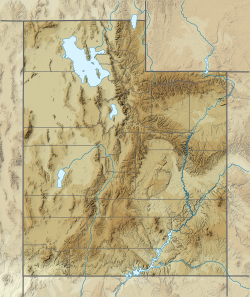| Adobe Mesa | |
|---|---|
 North aspect | |
| Highest point | |
| Elevation | 7,475 ft (2,278 m) [1] |
| Prominence | 375 ft (114 m) [1] |
| Parent peak | La Sal Peak [1] |
| Isolation | 4.98 mi (8.01 km) [1] |
| Coordinates | 38°36′37″N109°18′16″W / 38.6102693°N 109.3044669°W [2] |
| Naming | |
| Etymology | Adobe |
| Geography | |
| Country | United States |
| State | Utah |
| County | Grand |
| Parent range | Colorado Plateau [3] |
| Topo map | USGS Warner Lake |
| Geology | |
| Mountain type | Mesa |
| Rock type | Sandstone |
| Climbing | |
| Easiest route | class 2 [1] hiking |
Adobe Mesa is a 7,475-foot-elevation (2,278-meter) summit in Grand County, Utah, United States.


